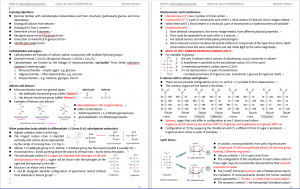I’ve got some emails from my beloved readers, asking for
I enjoy making revision notes after having that lecture (usually on weekends or over free time). The key difference between revision notes and lecture notes is that processed information are being listed in a logical manner with key annotations. Here are a few points I’d like to provide before posting an example of my revision notes:
1> Keep the wording short and concise: Trust you don’t want to read some hideous long paragraphs in some midnight to prepare for exams!
2> Include diagrams/graphs: Sometimes a good diagram/graph (preferably made of your own) can replace many lines of words!
3> A uniform system of colouring: E.g. Bold fronts for subheadings, Red colored fronts for highlighted notes, Bullet point system in primary subdivision and numbered list system in secondary subdivision, and so on. The point is to make sure you are not confused with your own layout.
4> Save while working all the time: Honestly, I don’t know how many times I’d almost smashed my laptop due to some ‘unexpected errors’ while working on my notes. Hours of work is gone in one second. That feeling…… 😛
5> Create proper subheadings: This really works if you wish to keep things organised! And it’s very useful in case you need to quick search on your notes 😛
6> Jot down learning objectives: This really helps by giving you some general ideas about what you would expect in this lecture. In most of the times, Learning objectives are provided by lecturers in the first PPT slide. Create your own if they weren’t given, just remember to be concise and general!
7> Delete and insert information: Some things lecturer mentioned might be irrelevant to this lecture of interest (E.g. blahblahblahblah…… you will see those stuff on XXX’s lecture in few months!) No, that part should not be of your concern right now. Expected independent study and your own outside reading outcomes are something you want to include in your revision notes as the extra bits 😛
8> Watch panopto lecture recordings if you have to: Imperial has a range of VLE (virtual learning environment) tools at your disposal to facilitate your studies. Panopto is a platform where lectures are recorded and uploaded to the cloud space. Note that some lecturers might be reluctant to have their lectures recorded! I usually put down a sign in my lecture notes to remind myself of watching panopto video of that particular bit. (This narrows down the part you need to watch!) You’ve got to pay extra attention if the lecturer is not gonna record the lectures.
That’s pretty much for the revision note tips I guess. Here is one page of the revision notes I did for a BCM lecture on Monosaccharides and Polysaccharides. (It would be really awkward for me if you spotted something wrong in that revision notes!!! 😛 😛 😛 )
Learning objectives
- Become familiar with carbohydrate nomenclature and their structures (particularly glucose and close derivatives)
- Distinguish aldoses from ketoses
- Distinguish D from L isomers
- Determine α from β anomers
- Recognise pyranose and furanose forms
- Draw chair or Haworth β-D-glucose forms
- Identify glycosidic bonds
Carbohydrates and sugars
- Carbohydrates are hydrates of carbon/ carbon compounds with multiple hydroxyl groups
- General formula: Cn(H2O)n like glucose Glucose: C6(H2O)6 / C6H12O6
- Carbohydrates are formed by the linkage of monosaccharides, Saccharide” from Greek sakcharon (σάκχαρο) meaning sugar
- Monosaccharides – simple sugars, e.g. glucose
- Oligosaccharides – often disaccharides, e.g. sucrose
- Polysaccharides – e.g. cellulose, glycogen, starch
Aldoses and ketoses
- Monosaccharides have two general types
- Has aldehydes functional group (called ‘aldoses’)
- Has ketones functional group (called ‘ketoses’)
- Examples of ketoses and aldoses
- Glyceraldehyde is the simplest aldose.
- IUPAC nomenclature:
- dihydroxyacetone = 1,3-dihydroxypropanone
- glyceraldehyde= 2,3-dihydroxypropanal
Fisher projection (only suitable to differentiate L-(-) from D-(+) carbohydrate molecules)
- Highest oxidation state is at the top.
- The longest carbon chain is depicted vertically with carbon atoms represented by the center of crossing lines. C1= top C
- Aldose: C of aldehydegroup is C1; Ketose: C of ketone group has the lowest possible # (usually C2).
- Horizontal lines = bonds pointing above the plane & Vertical lines = bonds below the plane.
- The penultimate carbon of D sugars are depicted with hydrogenon the left and hydroxyl on the right. L sugars will be shown with the hydrogen on the right and the hydroxyl on the left.
- Glucose is an aldose and a hexose
- L– and D– designate absolute configuration of asymmetric carbon farthest from aldehyde or ketone group?

There are pictures in the revision notes but it get really blurry if it’s got uploaded. I’m gonna post the picture anyway 🙂
Leave a comment below if you want to get this model version of revision notes 😛 I’ll figure out a way to sent this to you. And as always, leave your questions in the comment box below and I’ll answer them over the next post. See ya soon 🙂



